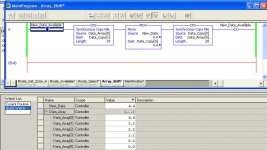klawson2012
Member
Hi,
I am using RSLogix 5000 V19 and I am trying to figure out how to shift reals in an array. Currently, I setup a flip-flop that increments a counter which increments the stored location in the array. This gets a little hairy when I get to the final location in the array because I then have to reset the counter back to zero and data is lost for one of the counts. I found some notes on the FIFO process but nothing has really helped me much.
Anyone have suggestions on how to create a rolling array of reals?
Thanks.
I am using RSLogix 5000 V19 and I am trying to figure out how to shift reals in an array. Currently, I setup a flip-flop that increments a counter which increments the stored location in the array. This gets a little hairy when I get to the final location in the array because I then have to reset the counter back to zero and data is lost for one of the counts. I found some notes on the FIFO process but nothing has really helped me much.
Anyone have suggestions on how to create a rolling array of reals?
Thanks.





